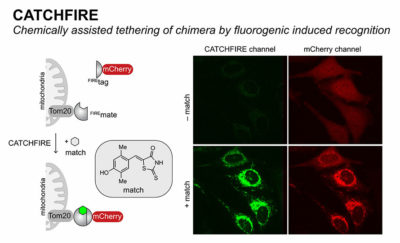CATCHFIRE! The name says it all: Chemically Assisted Tethering of CHimera by Fluorogenic Induced REcognition! In other words, a chemically induced proximity technology with intrinsic fluorescence reporting capabilities. Or, even shorter, a brandnew self-reporting protein dimerizer. A team led by Arnaud Gautier of Sorbonne University and Franck Perez of Institut Curie indeed disclosed CATCHFIRE days ago in Nat. Methods 2023.
Proximity between proteins plays an essential and ubiquitous role in many biological processes. Hence molecular tools enabling to control and observe protein proximity are essential for studying the functional role of physical distance between two proteins.
An evolution of FAST and splitFAST, CATCHFIRE implements the genetic fusion of proteins of interest to small dimerizing domains. Those further interact upon addition of fluorogenic inducers. Upon formation, ternary assemblies then fluoresce, allowing real-time monitoring of the chemically induced proximity. In the example pictured above, the two molecules of interest are mCherry and Tom20. They are fused to two small protein domains, Firemate and Firetag. Those are capable of interacting together in the presence of a small synthetic molecule, called “match”, playing the role of molecular glue. When both domains interact, then the match molecule sees its fluorescence increase by 100X. Researchers can then observe the newly induced interaction by fluorescence microscopy. A further key feature of CATCHFIRE is its reversibility, the first ever self-reporting reversible dimerizing system.
“While rapid and fully reversible, CATCHFIRE allows the control and tracking of protein localization, protein trafficking, organelle transport and cellular processes. It hence opens new avenues for studying or controlling biological processes with high spatiotemporal resolution. Furthermore, its fluorogenic nature allows the design of innovative biosensors for the study of various processes, such as signal transduction and apoptosis”
Prof. Arnaud Gautier & Dr. Franck Perez
Read more about Catchfire, self-reporting protein dimerizer
A fluorogenic chemically induced dimerization technology for controlling, imaging and sensing protein proximity. Sara Bottone, Octave Joliot, Zeyneb Vildan Cakil, Lina El Hajji, Louise-Marie Rakotoarison, Gaelle Boncompain, Franck Perez, Arnaud Gautier. Nature Methods, 28 August 2023 – https://doi.org/10.1038/s41592-023-01988-8
Fluorogenic chemically induced dimerization. Wang, W., Shen, J.. Nat Methods 20, 1454–1455 (2023) – https://doi.org/10.1038/s41592-023-01989-7
Monitoring protein proximity with fluorogens. Despang, A. Nat Biotechnol 41, 1386 (2023). https://doi.org/10.1038/s41587-023-02000-6

Recent Comments